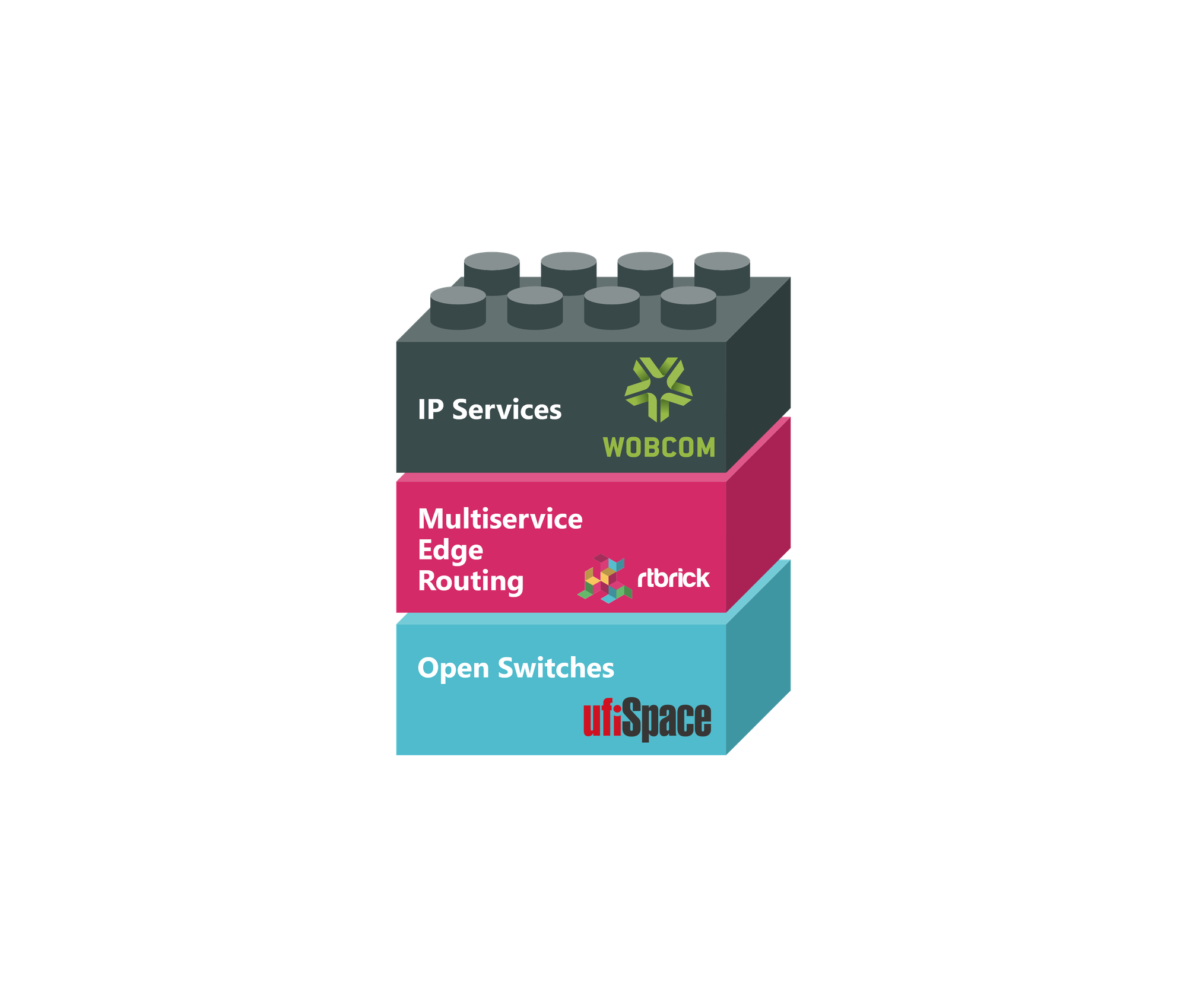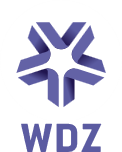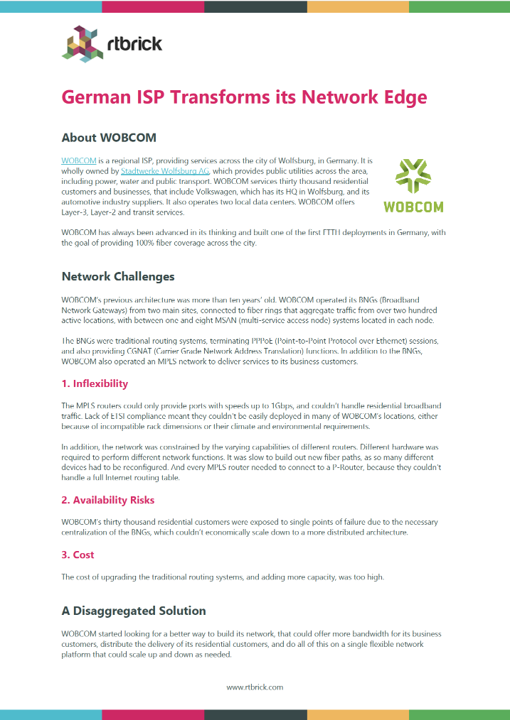WOBCOM, a regional ISP in Germany

Find out how WOBCOM, a regional ISP, rebuilt their network edge with a disaggregated approach that was easier to automate, lowered their costs and was an architectural game-changer.
Financially Beneficial | Functionally Superior | Architectural Game-Changer |
“Disaggregation allows us to mix and match hardware and software. The open switches cost far less than traditional routers. It’s easy for us to shop around and pick the best deal. And we no longer have to rely on supply from a single vendor.” | “We’ve only found a few router vendors that you could describe as ‘automation friendly’ and RtBrick is the best of the pack. It was very simple for us to automate our operations using the RtBrick software, without needing to spend time working around vendor limitations.” | “We are no longer forced to adapt our network to the limitations of the physical world. We aren’t restricted by the different features of each box. We simply pick the best form-factor and ports required for any location and everything is available to us.” |
WOBCOM is a regional ISP, providing services across the city of Wolfsburg, in Germany. It services thirty thousand residential customers and businesses, that include Volkswagen, which has its HQ in Wolfsburg.
...or read more below.
German ISP Transforms its Network Edge
About WOBCOM
WOBCOM is a regional ISP, providing services across the city of Wolfsburg, in Germany. It is wholly owned by Stadtwerke Wolfsburg AG, which provides public utilities across the area, including power, water and public transport. WOBCOM services thirty thousand residential customers and businesses, that include Volkswagen, which has its HQ in Wolfsburg, and its automotive industry suppliers. It also operates two local data centers. WOBCOM offers Layer-3, Layer-2 and transit services.
WOBCOM has always been advanced in its thinking and built one of the first FTTH deployments in Germany, with the goal of providing 100% fiber coverage across the city.
Network Challenges
WOBCOM’s previous architecture was more than ten years’ old. WOBCOM operated its BNGs (Broadband Network Gateways) from two main sites, connected to fiber rings that aggregate traffic from over two hundred active locations, with between one and eight MSAN (multi-service access node) systems located in each node.
The BNGs were traditional routing systems, terminating PPPoE (Point-to-Point Protocol over Ethernet) sessions, and also providing CGNAT (Carrier Grade Network Address Translation) functions. In addition to the BNGs, WOBCOM also operated an MPLS network to deliver services to its business customers.
1. Inflexibility
The MPLS routers could only provide ports with speeds up to 1Gbps, and couldn’t handle residential broadband traffic. Lack of ETSI compliance meant they couldn’t be easily deployed in many of WOBCOM’s locations, either because of incompatible rack dimensions or their climate and environmental requirements.
In addition, the network was constrained by the varying capabilities of different routers. Different hardware was required to perform different network functions. It was slow to build out new fiber paths, as so many different devices had to be reconfigured. And every MPLS router needed to connect to a P-Router, because they couldn’t handle a full Internet routing table.
2. Availability Risks
WOBCOM’s thirty thousand residential customers were exposed to single points of failure due to the necessary centralization of the BNGs, which couldn’t economically scale down to a more distributed architecture.
3. Cost
The cost of upgrading the traditional routing systems, and adding more capacity, was too high.
Watch Fiona Weber, from WDZ, describe the WOBCOM deployment and experiences at DENOG16 (German Network Operators Group)
A Disaggregated Solution
WOBCOM started looking for a better way to build its network, that could offer more bandwidth for its business customers, distribute the delivery of its residential customers, and do all of this on a single flexible network platform that could scale up and down as needed.
“We decided to take a more modern approach to our new architecture and build it using disaggregated network systems,” said Jan Marienfeldt, Team Lead for Network Infrastructure and Planning at WOBCOM. “We used open switching hardware from UfiSpace and routing software from RtBrick to provide the BNG functionality and core-facing protocols we needed.”
Switching Hardware
WOBCOM realized that by adopting a disaggregated network, they could mix and match hardware independently of network function, selecting the best platform for each location based on throughput, port speeds, size and environmental requirements. They used a range of Ufispace switches based on Broadcom Q2C and Q2A and QAX chipsets. They increased their hardware options even further by validating open switches from Edgecore, so they could also be used in the future, if needed.

Ufispace 9510-28DC Open Switch
WOBCOM deployed Ufispace S9600-32X switches, to provide 100Gbps upstream ports. Ufispace S9600-72X switches were used to provide large PE Routers and BNGs in the data centers. Smaller Ufispace 9510-28DC switches distributed BNG functions further out in the network. And Ufispace 9500-22XST switches were deployed in smaller sites to provide business services or as customer-site routers that could aggregate multiple services on premise. This was a highly efficient way of delivering several services over a single connection whilst supporting its customers’ legacy equipment.
WOBCOM continues to add new sites and capacity to its network, selecting whichever sized hardware is most appropriate at any location.
Routing Software
WOBCOM deployed RtBrick’s multiservice edge routing software on the open switches, which is optimized to work on the underlying bare-metal silicon in the open switches. It runs as a container in Open Network Linux, which is provided with the switches.
Subscriber services are delivered using PPPoE. The core is connected using IS-IS Segment Routing with labeled BGP. The Layer-2 transport uses EVPN (Ethernet VPN). The RtBrick software also runs BGP Flowspec, which is a powerful tool used to help protect networks from DDoS (Distributed Denial of Service) attacks.
OSS
WOBCOM provisions new users using data from its NetBox system, which is rendered into Yang model templates and Netconf for deployment. The template is written using the Nix programming language, using config files that declare each router’s entire state, validated against the Yang model, then pushed to the router. This also allows WOBCOM to share the same source of data across both the new network and its older legacy routers.
Network data is gathered using Prometheus, an open-source time series database. Operational data is then visualized, and alerts generated, using Grafana, which is a multi-platform open-source analytics and interactive visualization web application.
“Operationally, the RtBrick software was a perfect match for WOBCOM’s existing infrastructure, because we’d already adopted a modern approach to network operations, using Prometheus and Grafana,” explained Christian Dieckhoff, Project Manager at WDZ.
End-User Services
The new network delivers residential broadband services with symmetrical throughputs at speeds from 100Mbps to 1Gbps, and business services up to 100Gbps.
The implementation experience
Working with RtBrick
To increase the speed of implementation, WOBCOM decided to deploy the RtBrick software into its production network at an early stage.
“This turned out to be a good decision and we never regretted it,” said Christian Dieckhoff. “We deployed the systems and, in general, they just worked. Of course, we found some issues along the way, but when we did, they were all resolved at short notice. RtBrick enabled us to deploy and automate the network quickly and without much effort. It was an environment of listening, responding and acting.”
WOBCOM also worked with German developer and integrator WDZ to help them implement and automate operations across their new network architecture. “We shared our objectives with WDZ and they made it happen,” said Jan Marienfeldt.
Working with WDZ
WDZ performed the engineering development work for the new architecture, including verification, testing, configuration set-up, ZTP (Zero-Touch-Provisioning), and automation. They also supplied WOBCOM with RtBrick software licenses and support.
“WDZ is the enabler and developer, focussing on warehouse-to-production,” said Fiona Weber, Lead Architect at WDZ. “And then WOBCOM only needs to worry about deployment and expansion.”
WOBCOM procure the open switch hardware themselves, and are free to choose whichever vendor and platform they wish. They also do the installation and roll-out. They simply decide where to put the switches and what scale they need at any location. At this point they are no longer dependent on WDZ.
“WDZ is still there to bring on board a new service when needed, configuring Prometheus and Grafana dashboards, for example,” adds Fiona Weber.
As they developed the solution and automation, WDZ particularly valued RtBrick’s approach to technical documentation.
“The amount and quality of the RtBrick documentation gave us a really fast learning-curve. And because all the documentation is openly available, often we could simply use Google to find what we needed,” said Fiona Weber. “The RtBrick network operating system felt somewhat familiar from day one, as though we already knew it. It made it easy for our developers to interact with it, and where we started with unknowns, those blank pages filled up very quickly.”
Key Benefits of the RtBrick Solution
WOBCOM have identified several key advantages from their newly deployed disaggregated network. “Our disaggregated RtBrick network costs substantially less, is easier to automate and gives us far greater architectural flexibility,” said Jan Marienfeldt.
Financially Beneficial
“Disaggregation allows us to mix and match hardware and software,” explained Jan Marienfeldt. “The open switches cost far less than traditional routers. It’s easy for us to shop around and pick the best deal. And we no longer have to rely on supply from a single vendor.”
In addition to enjoying lower costs of acquisition, WOBCOM also valued the way that disaggregated networks add to their costs in small increments, proportional to their revenues.
“This really is a ‘pay-as-you-grow’ approach,” said Christian Dieckhoff. “The software licensing is very flexible, and we can add hardware in small increments as we need it. We started the whole project by deploying a single five-thousand Euro switch into our network.”
Functionally Superior
WOBCOM also found the disaggregated solution simpler to automate.
“We’ve only found a few router vendors that you could describe as ‘automation friendly’ and RtBrick is the best of the pack,” said Fiona Weber. “It was very simple for us to automate our operations using the RtBrick software, without needing to spend time working around vendor limitations.”
Architectural Game-Changer
All of WOBCOM’s networking functions can now be delivered across a choice of devices, from core to aggregation to edge, and that switch can vary in size and capacity, independent of network function.
“We are no longer forced to adapt our network to the limitations of the physical world,” said Jan Marienfeldt. “We aren’t restricted by the different features of each box. We simply pick the best form-factor and ports required for any location and everything is available to us.”
“RtBrick was the only vendor able to offer the entire feature-set we needed on this type of hardware,” added Christian Dieckhoff. “They provide core routing protocols along with PPPoE termination performed on an ASIC, all on a variety of throughputs and form-factors, while providing L2 and L3 services at the same time.”
By using RtBrick’s software, WOBCOM have completely eliminated an entire aggregation layer, as they can now physically terminate their MSANs and logically terminate subscriber traffic on the same switch. The capability to scale-down across different sizes of hardware has also brought their services closer to their customers, with BNG functions often less than one hundred meters from subscribers.
Next Steps
WOBCOM has plans to further expand the functionality provided by their new disaggregated network. These include delivering 400G business services and using the new network to replace their existing CGNAT solution. They also plan to bring RtBrick into their peering network, handling traffic that has to leave Wolfsburg and go to external data centers. This will allow them to keep growing bandwidth and add more ports that can also operate Flowspec, which provides better filtering capabilities to deal with DDoS attacks.
“This will be a game-changer for WOBCOM,” said Jan Marienfeldt, “as peering is currently a very expensive solution which requires centralization, as well as using another aggregation layer that we can then remove.”
Finally… some advice to others
Christian Dieckhoff had this advice for any other operators finding themselves in a similar position to WOBCOM. “I would just say that now is the time to trust in the new disaggregated technology. The implementation and consulting effort is no more than for established equipment and you can rely on the quality of the open documentation. Disaggregation is ready for the production network and allows you to automate your operations more easily than ever before.”
Download the case study


